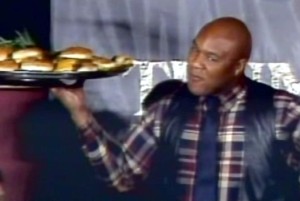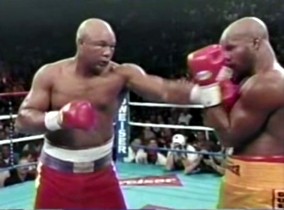 15.06.07 – By James Slater: There is little doubt that the return to the boxing ring of former heavyweight king George Foreman added excitement and intrigue to the sport of boxing.
15.06.07 – By James Slater: There is little doubt that the return to the boxing ring of former heavyweight king George Foreman added excitement and intrigue to the sport of boxing.
Indeed, when Foreman scored his miraculous seeming win over WBA and IBF title holder Michael Moorer in 1994 people the world over, not merely dedicated fights fans, once again knew who the heavyweight champion was. This was obviously good for boxing. Yet did George, in his unlikely comeback, actually do more harm than good to the big boys’ weight class? Would the current situation with the aging Evander Holyfield, for example, who is still fighting at age forty-four, be happening were it not for Big George’s amazing accomplishments?
And Evander is just one of a quite alarming number of veteran heavyweights plying their trade today. It’s a fact these days that there are too many old fighters still believing they can once again find themselves at the top of the sport they once dominated. Now, twenty years after his astonishing comeback began, I ponder the notion that Big George was, at least partially, the reason for this and the less than stellar condition the heavyweight boxing division is in now.
There have always been comebacks in boxing, and there always will be. The sight of former great champions and club fighters alike making returns to the ring when past their best in pursuit of more money or glory, or both, is nothing unfamiliar to fight fans. As long ago as the early 1900’s, a time when the gloved era was still comparatively new, former champions in the heavyweight division were enticed to come out of retirement and challenge the current ruler. Famously, this happened with Jim Jeffries, who had retired unbeaten – only to be urged back into the ring so he could wipe the smile off the new – and black – champ’s face in Jack Johnson. Sadly Jeffries listened to the desires of the racists and boxed the much younger and fitter Johnson – and was badly beaten as a result.
In more recent times the exploits of Sugar Ray Leonard kept the fans enthralled as he mounted comeback after comeback – most of which were successful ones. But there has never been a comeback quite like the one George Foreman made twenty years ago this year. In fact, Foreman’s success was such that no sooner had he shocked the world and regained his old crown in 1994 – and with it millions and millions of dollars – ex-heavyweights from as long ago as the late 1960’s were dusting off their boxing gloves and sweating away in obscure gyms in the hopes of repeating what George had just done. Quite simply, George had changed the landscape of the whole heavyweight division with his remarkable come from behind KO of world champ Michael Moorer. The division would never be the same again.
 Emulating Foreman was not always something fellow ex-fighters wanted to do, however. Back in 1987, when George fought again for the first time in ten years, almost everyone either laughed or worried out loud for his safety. His safety and the reputation of the sport he was competing in again. You can’t do it, they said. Not at age thirty-eight, and not when carrying so much weight. George had indeed weighed-in for his fight with Steve Zouski carrying a lot more poundage than he had when fans had last seen him, losing to Jimmy Young. And boxing while aged almost forty, was, back then, looked upon as dangerous and embarrassing. Still, George ignored the critics, one of which was his former trainer Gil Clancy, who had refused to get involved in his former fighter’s crazy comeback idea, and carried on.
Emulating Foreman was not always something fellow ex-fighters wanted to do, however. Back in 1987, when George fought again for the first time in ten years, almost everyone either laughed or worried out loud for his safety. His safety and the reputation of the sport he was competing in again. You can’t do it, they said. Not at age thirty-eight, and not when carrying so much weight. George had indeed weighed-in for his fight with Steve Zouski carrying a lot more poundage than he had when fans had last seen him, losing to Jimmy Young. And boxing while aged almost forty, was, back then, looked upon as dangerous and embarrassing. Still, George ignored the critics, one of which was his former trainer Gil Clancy, who had refused to get involved in his former fighter’s crazy comeback idea, and carried on.
He boxed in tank towns all over America, slowly but surely getting in better condition as the rust began to fall off. Then, quite gradually, something began to happen. George became a cult figure. The fans would always turn out to see him fight and later, when T.V was ready to go near him, his figures became huge. The fans loved his comeback and rooted for him wholeheartedly. The experts may still have moaned, but Big George now had an army of fans.
This was not lost on the promoters. Bob Arum started promoting George, and, after an early fall-out – brought about by George’s refusal to fight anyone other than his own choosing – Foreman allowed Arum to match him with Gerry Cooney. Cooney may have been looked upon as yet another joke opponent for George – coming as he was out of a two-and-a-half year absence himself – but the occasion was a sell-out. Caesars Palace in Atlantic City was full to the brim on January 15th 1990, full of fans curious to see what would happen in a fight that had been dubbed “The Preacher Vs. The Puncher.” Adding to the drama was the fact that Clancy, the man who had said no to George, would be in Gerry’s corner. It didn’t matter. Foreman blitzed Cooney in two impressive rounds and was now a pay-per-view attraction. As well as a serious challenge to Mike Tyson, according to his loyal fans.
It wasn’t until George’s inevitable title shot – which came against new ruler Evander Holyfield, however, that some of George’s fellow retirees got the urge to try their hand at doing what he was doing. Larry Holmes was so inspired by Foreman’s ability to go the full twelve rounds with “The Real Deal” that he decided to box again also. Not since his destruction at the hands of Tyson – who had been shocked by Buster Douglas a month after Foreman-Cooney, who in turn was KO’d by Holyfield – had Larry boxed. Foreman’s success forced a re-think.
This was where the era of heavyweight boxing we have today was born. Some of the purists may have cried out in fury that veteran after veteran was now rejoining the heavyweight ranks, but the fact is Foreman had changed heavyweight boxing. For good or for bad, George, as his brother Roy had always said he’d been looking forward to the day of it happening, had changed the average person’s thinking when it came to an acceptable age for a man to fight at. No longer was the age of forty deemed, as George himself liked to put it, “A death sentence.” And if the purists weren’t happy now, things were going to get even worse. When Foreman finally made his very serious dream of regaining the title he’d lost to Muhammad Ali a reality – by beating the much younger Moorer in a tenth round KO in November 1994 – the flood gates opened.
Big name after big name from the mists of time in the heavyweight division re-emerged. Some of these fighters were actually Foreman’s old adversaries. Men like Ron Lyle, who Foreman had an up and down thriller with during both men’s hey day, climbed back into the ring almost as soon as he’d heard the news of George’s unlikely triumph. Even more bizarrely, Levi Forte, the man who Foreman had beaten way back in 1969, and who was now aged forty-eight, came back too. What had George done?, was the question begged by those who feared the worse. Who else would creak back into the ring? Well, fifty year old Earnie Shavers did, losing one and wining one in 1995. Things were getting out of hand.
Of course, George couldn’t be held accountable by anyone – even if his actions had clearly inspired the new “Seniors’ Tour” amongst the big men of boxing. George’s great history making win over Moorer had been celebrated, George had exorcised all the demons that had been inside his head ever since he’d fallen to Ali, and he’d made an absolute fortune. Now he seemingly had no more use for boxing. He fought on, sure. Under his own terms he boxed against who he wanted, where he wanted and when he wanted, winning a few fights, to the likes of Axel Schulz and Lou Savarese – before finally retiring for good after losing to Shannon Briggs, in 1997.
Since then George has had little to do with his former sport. He no longer commentates, isn’t seen around ringside much any more and isn’t likely to become a trainer or anything of that ilk . In actuality he has reinvented himself once again. Indeed, George has had some kind of eventful life. He has been a mean and moody, intimidating heavyweight, very much in the Sonny Liston mould, has been a born again preacher, a cult icon, a history maker, and is now a multi-million selling grill salesman.
But has George left the heavyweight division in worse or better shape that it was in when he came back to it in 1987? One look at the average age of today’s heavyweight might give you a clue. For there are a throng of contenders and title holders in their mid-thirties or older – men like Maskaev, Toney and Briggs, for example. While on the fringes of the top-ten there are many active veteran heavyweights. Oliver McCall is forty-one, Michael Moorer, in a little twist of irony, is still fighting at age thirty-nine, as is another former Foreman opponent in Holyfield, at forty-four, and so the list goes on. Back in 1986, though, before Foreman decided he needed to make some cash for his youth centre, this wasn’t the case.
One need only listen to what these fighters are saying to see where they get the go ahead to justify, at least in their own minds, what they are doing in the boxing ring at their advanced age. Take Oliver McCall, for instance. “ God bless the George Foreman’s and the Larry Holmes.’ Those great champions came back and what they did, Foreman in particular, can be duplicated. Those guys are a huge inspiration for what I’ve got to do.” Clearly, the “Atomic Bull” looks at what Foreman was able to accomplish and wants to do likewise. What about Evander Holyfield? “ George did it [regain the title] at forty-five and I don’t think he was in nearly as good a shape as I am at forty-four. I know what I can do.” Listen to these men talk and it’s obvious who drew up the blueprint for what they are doing. There is little doubt, it’s as a result of what “The Punching Preacher” did that today’s heavyweight landscape is abound with so many veterans.
He certainly put smiles on plenty of faces with his unlikely boxing comeback, but the division George Foreman left behind him is not a happy or a pleasing one, is it?
(Article originally published by Inside Boxing.com)